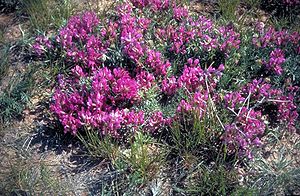Astragalus crassicarpus
| Astragalus crassicarpus | ||||||||||||
|---|---|---|---|---|---|---|---|---|---|---|---|---|

Astragalus crassicarpus |
||||||||||||
| Systematics | ||||||||||||
|
||||||||||||
| Scientific name | ||||||||||||
| Astragalus crassicarpus | ||||||||||||
| Nutt. |
Astragalus crassicarpus , known in English as ground-plum or buffalo-plum ( "Erdpflaume" or "buffalo plum"), is a Tragant - kind from the family of legumes (Fabaceae). This Schmetterlingsblütler is a typical plant of the grass lands of the Great Plains , in common with many closely related species of the prairie.
features
The inconspicuous herbaceous plant is persistent, mostly only ankle-high, creeping. As with other tragacanth species, the leaves are composed of numerous small, green leaflets and are pinnate unpaired, the number of leaflets is usually around 8-13 pairs of leaflets and one unpaired terminal leaflet.
The inflorescence consists of small, umbel-like or loosely racemose clusters of purple-white butterfly flowers, which are rather narrow, as in the vetches.
The fruits develop on the ground, lying between the stems. They consist of plum-like, juicy balls. Older fruits take on a woody-brown to purple hue, especially on the side facing the sun. The surface is smooth and shiny. They are divided into two chambers inside, which contain numerous seeds.
The flowering period extends from May to June.
The number of chromosomes is 2n = 22.
Occurrence
The range extends from southern Canada (Alberta, Saskatchewan, Manitoba) down to Mexico, covers large parts of the central prairie country, including the Missouri region, and extends from Texas to Montana. With constant overgrazing, the population declines.
Astragalus crassicarpus occurs in the dry grasslands of the Great Plains because, as a legume , it can bind nitrogen through a symbiosis with nodule bacteria . These plants are therefore an important natural fertilizer and soil conditioner in those barren areas. Therefore, the plant can still thrive in semi-desert areas. However, she avoids clay soils.
use
Green fruits that are still young are sweet and have a taste that is reminiscent of raw green beans. However, this plant has numerous poisonous relatives, including the so-called " Locoweed " (= English-Spanish: literally: "Madness herb"), so consumption is not recommended. (This applies to all those American tragacanth species that are potentially classified as “edible” or as tea, as poisonous or selenium-storing closely related “doppelgangers” are common. Even with principally non-toxic species such as the particularly conspicuous and fleshy buffalo plum, there is persistence through ingestion pollutants from the soil pose a latent risk of poisoning.)
The Lakota Indians (= Western Sioux) traditionally use the plant as "horse medicine", presumably as a stimulant to stimulate appetite, since herbivores like to graze on the herbaceous parts.
swell
- James R. Johnson, Gary E. Larson: Grassland Plants of South Dakota and the Northern Great Plains . Brookings 1999, ISBN 0-913062-06-5 .
- Rebecca Netzel: Animal Nation and Plant Nation. A Fieldguide for Lakóta Children and for all those adults who still care about Creation . WVT, Trier 2007, ISBN 978-3-88476-945-4 .
- Theodore Van Bruggen: Wildflowers, Grasses and Other Plants of the Northern Plains and Black Hills . 5th edition. Rapid City 2003, ISBN 0-912410-05-1 .
- Frank D. Venning: A Guide to Field Identification - Wildflowers of North America . Golden Press, New York / Racine, Wisconsin 1984, ISBN 0-307-13664-7 .
- Susan J. Wernert (Ed.): North American Wildlife . 15th edition. Pleasantville, NY 1991, ISBN 0-89577-102-0 .
Individual evidence
- ^ Astragalus crassicarpus at Tropicos.org. In: IPCN Chromosome Reports . Missouri Botanical Garden, St. Louis

